By Rick VanSickle
Niagara winemaker Wes Lowrey writes a lavishly detailed blog on exactly how he grows the grapes for his much-sought-after wines from Five Rows Craft Wine and how what goes into the making of them.
His Wine Makers Blog dives deep into the minutia of each and every varietal made into wine at Five Rows and the full journey from vine to bottle. It’s always a brutally honest dialogue with vintage notes (good and bad), cellaring outlook and the trials and tribulations of making wine in Niagara, in particular, on the St. David’s Bench.

It’s these kinds of observations and full disclosure that appeals to die-hard wine club members and fans of Five Rows who pretty much deplete the small wine boutique winery of each bottle of wine every vintage before summer ends — in fact, a couple of varietals are sold out before they are even released (go ahead, just try and get you hands on a bottle Sauvignon Blanc from any vintage). If you want to see passion and dedication, check out the provenance section of the Fives Rows website where consumers track their numbered wines and offer comments as they open the wines from their cellars. The comments are telling — a knowledgeable community of wine lovers who share thoughts on when to open their cellared treasures or updates on the progress of the wines.
Fives Rows needs no help selling their wines and still has no plans of increasing the tiny production at the winery from their small estate plantings (most of which is sold to enthusiastic wine club members).
I line up up like everyone else to taste the Five Rows wines annually and often taste with wine-loving friends of mine from Toronto, who buy the full complement of wines there every year. My friends have eclectic tastes and a stellar cellar bursting at the seams with wines they covet from myriad regions. They will tell you that the last thing they need is more wine, but some things are too good to pass up, and the Five Rows portfolio — all of them! — is one of those wines.
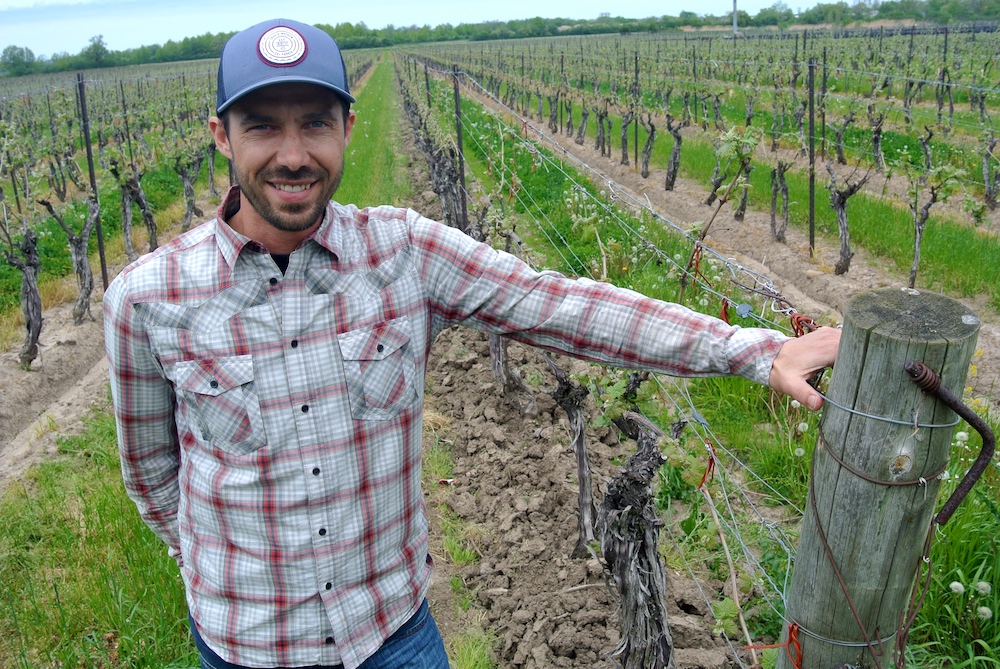
When I arrive to taste with Lowrey, above, it’s always like a big homecoming for David (real name protected as he is a private guy). His allotment of wines is already spoken for, but he likes to taste them all with the winemaker and Lowrey is only too happy to oblige, taking a break from his most favourite thing in the world — tending to the grapes right outside the tiny tasting room/winery.
Wilma, Wes’s mother, is usually around as she does most of the greeting and pouring in the spring and early summer (and also hand inscribes the bottles with each number and vintage). There are always big hugs and catching up to do before the tasting and genuine warmth and friendship for her repeat customers who drive far and wide for their treats.
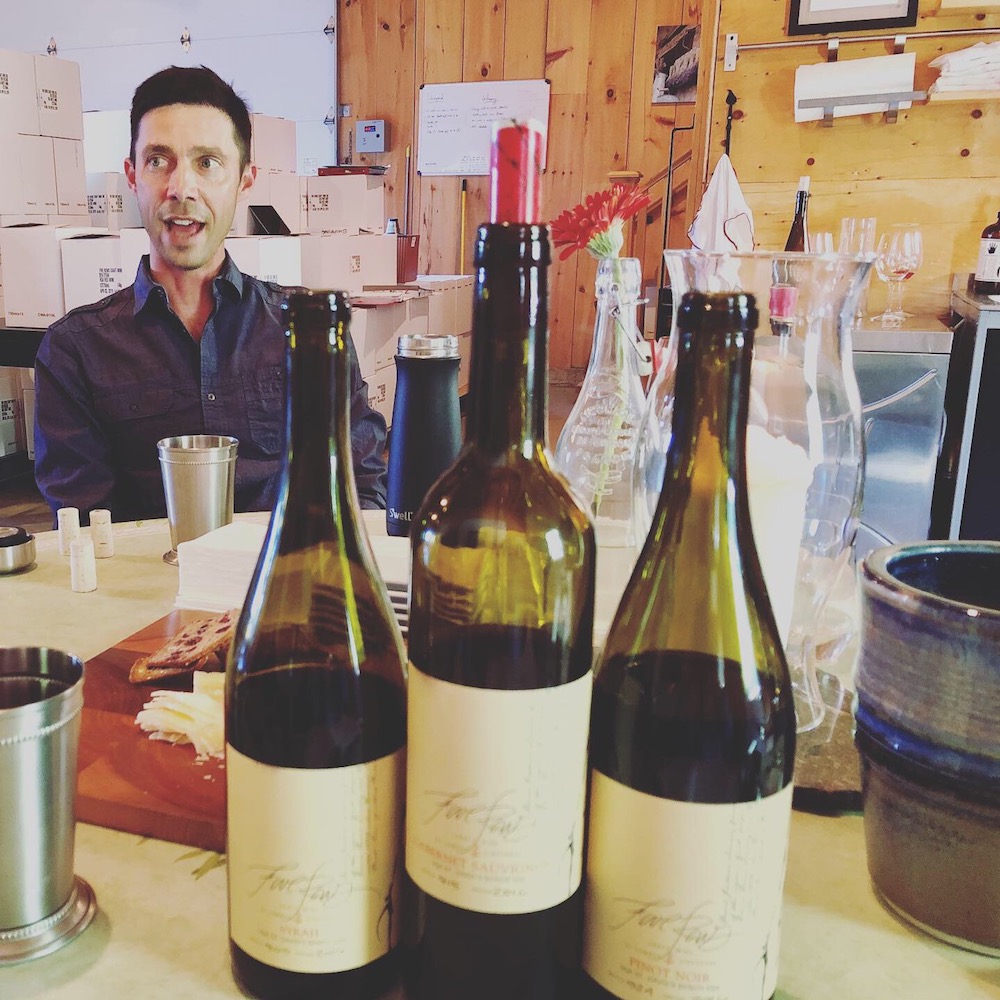
David is an avid wine collector, as mentioned, and that includes wines close to home such as Niagara and Prince Edward County that he proudly includes in a cellar with the finest wines in the world. Five Rows is one of those he collects every vintage.
Five Rows released 2018 whites and 2016 reds from the six key varieties at the farm, which Lowrey makes into single-variety wines. It’s a rare occurrence to get the white and red release vintages on the same path, with 2018 a hot vintage for white varietals (if you picked before the strange and rainy fall) and 2016 also extremely hot and favouring the Bordeaux varieties such as Lowrey’s beloved Cabernet Sauvignon.
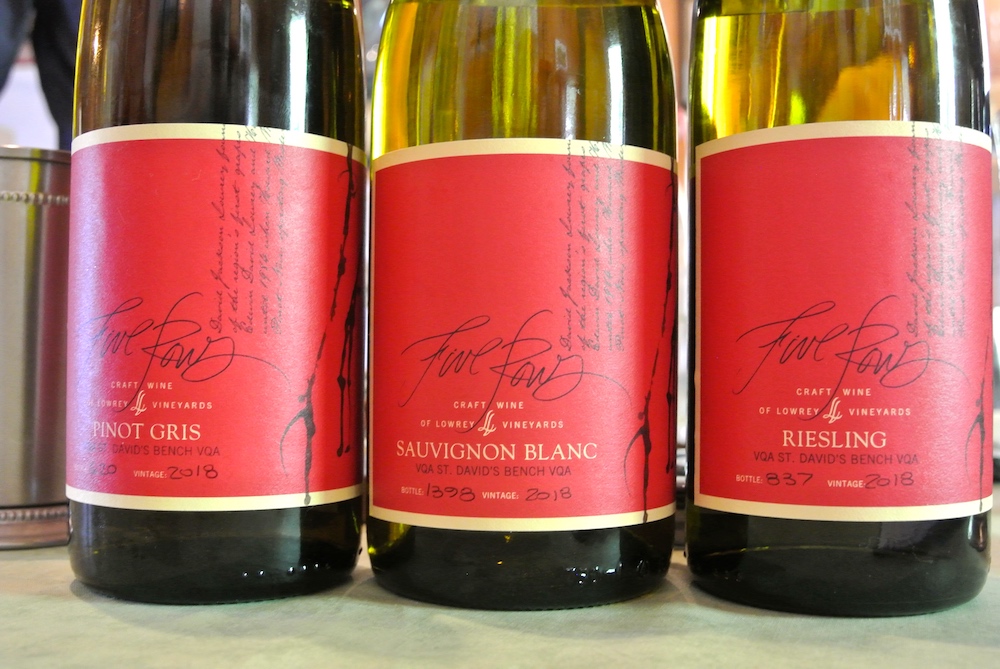
Here is what we tasted at Five Rows recently. And, I’m sorry, a lot of these might already be gone, so let this serve as reminder to order early next vintage. I’ve included some of Wes’s detailed notes on each wine.
The Whites

Five Rows Craft Wine Sauvignon Blanc 2018 ($35, 93 points) — I asked Lowrey why this wine is the first to be sold out every year, usually spoken for (and untasted) before the winery opens its doors in spring. “It’s a perfect storm of it being a decent wine, and it being a bit of a cult wine,” he says. “When people think they can’t get something it tends to sell quicker.” I think it’s more obvious than that: It’s a damn fine Sauvignon Blanc and the 2018 version is the best yet made at Five Rows. Lowrey ferments 75% of the fruit in old French oak barrels (newest barrel is 10 years old) and the rest in stainless steel. It has an explosive, yet elegant, nose of integrated spices, gooseberries, grapefruit, pear and passion fruit with just a hint of herbs and grassy notes. On the palate, it’s rich, textured and simply beautiful in all aspects with depth of fruit — gooseberries, citrus, pear, passion fruit — joined by subtle spicy notes and all propped up by mouth-watering acidity, which was extremely hard to do in 2018, by the way. This is not a Sauvignon Blanc to lay down for years and years, but certainly it will give you pleasure for 3+ years. It is irresistible right now. “I still get excited making this every year,” Lowrey says. “It’s a bit intimidating, but I have in my corner other winemakers to help with picking decisions.”
Winemaker’s notes:
I embrace the opportunity to work with Sauvignon Blanc as a varietal, but over the years it has proven to be a wine of unforeseen challenges and pressure.
First there are the viticultural challenges. Canopy management and vine balance proved to be those hurdles in 2018 — creating adequate fruit exposure to combat the higher disease pressure, but not so much to bake the berries in the scorching heat. Thankfully, no irrigation was needed in these deep-rooted old vines, which was advantageous in weathering the dry conditions we faced in May, June and July.
Each year the harvest timing decision in our Sauv Blanc is ultimately made on flavour development in the berries, which – like acidity levels – can vanish overnight if you are not careful. Our rows were harvested on September 4th, with ideal parameters for crafting aromatic and lively Sauv Blanc (20.4 degrees Brix, 8.0 g/L TA).
Then there are the stylistic challenges (i.e. the pressure to get it right!). Based on what has worked in previous ripe vintages, I chose to ferment 75% of the juice in neutral French oak and the remaining 25% in stainless steel.
Finally there are the logistical challenges. We produced 220 cases of 2018 Sauv Blanc, by far our largest bottling, but I anticipate that will not be quite enough to meet the demand. So why not just make more? For starters, it is difficult to source clean, previously used white wine barrels. The seven older barrels I currently use average ten years of age, and will need to be gradually replaced in the near future. Incorporating a brand new barrel into the fray might be necessary, but at what cost to my preferred style? I’m hoping the answer lies in a new barrel I’ve sourced (“Piano” – by Tonnellerie Rousseau) that comes highly recommended for it’s gentle treatment of aromatic whites.
Production: 220 cases
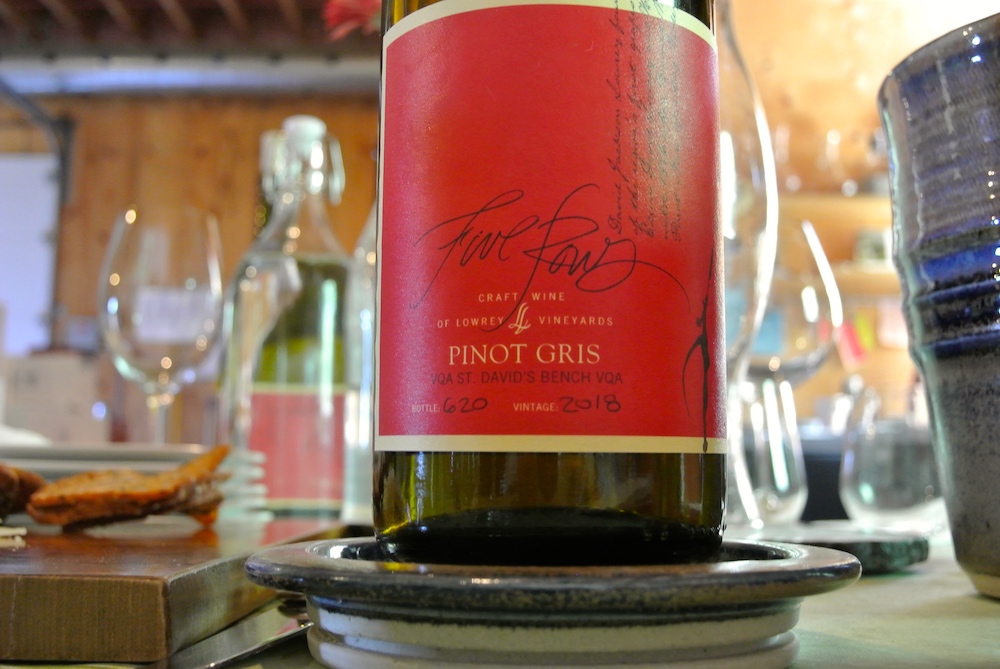
Five Rows Craft Wine Pinot Gris 2018 ($35, 92 points) — There is a light salmon hue to this Gris in the glass, just from the pressing. Up to 60% of the juice was fermented in neutral French oak barrels and the rest in stainless steel. It has a personable nose of grapefruit, honeydew melon, apricot, tangerine and baked apple notes. It’s fleshy and texturally appealing in the mouth with peach cobbler, apple, melon and apricot flavours with just a kiss of honey on the finish. Drinking deliciously right now.
Winemaker’s notes:
Our Pinot Gris block is currently the smallest of our plantings. Just an acre or so of vines, struggling away in the heaviest clay on our farm. Although generally beneficial for wine quality, the clay soil has led to inconsistent vine vigour issues over the years.
I’ve never minded the small size of the block, as Pinot Gris is my nemesis when it comes to disease pressure, vine upkeep and training … so, of course, we’ve decided to plant more in 2019! I will no doubt regret this decision on many occasions in the future, but for now I will bask in the joy of young vines and untapped potential. Expect to taste this fruit sometime after 2021.
The warm, dry summer of 2018 helped produce some very ripe, thick-skinned Pinot Gris by early September. About 2000 kg were harvested on September 4th, after three days of painstaking Botrytis removal (not an easy task in PG!). We chose to pick at an optimal TA level (7.7 g/L) to avoid having to supplement with tartaric acid. 60% of the juice was fermented in neutral French oak barrels and 40% in stainless steel. It was fermented cool (9 C) for 21 days, and stopped at a specific gravity of 0.998. Partial spontaneous malolactic fermentation took place in the barrel-fermented portion of wine.
The thicker skins are evident in the pinkish-gold colour and unmistakable texture of this wine, which also features aromas of apricot, baked peach, honey and vanilla.
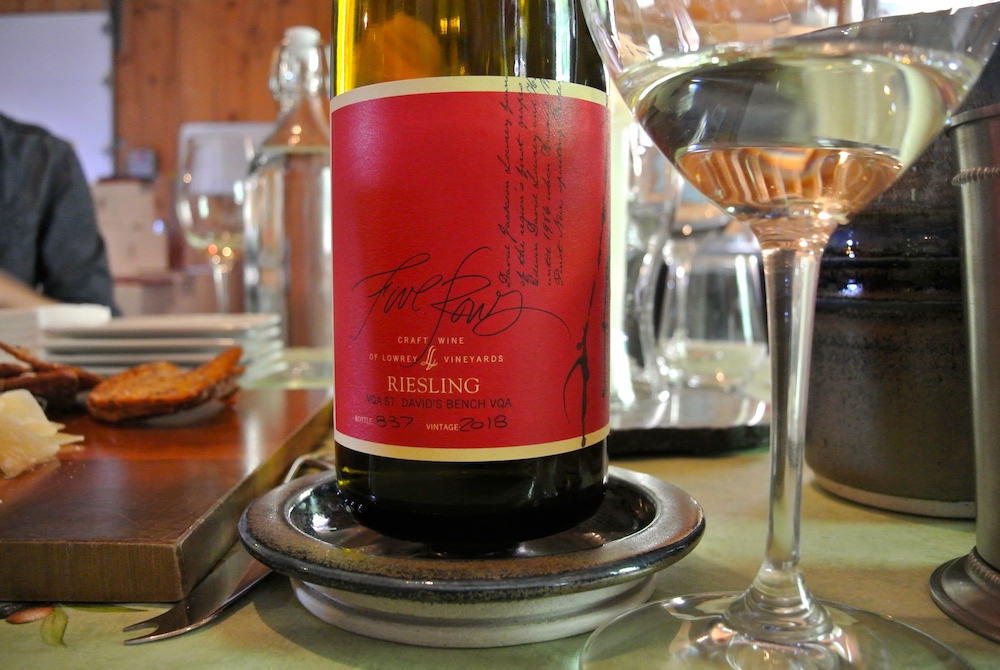
Five Rows Craft Wine Jean’s Block Riesling 2018 ($35, 91 points) — Avoiding some botrytis was nearly impossible in Niagara Riesling vineyards in 2018, but in the Lowrey Vineyard and surrounding vineyards of St. David’s, it’s a rarity that there isn’t some botrytis fruit. I happen to like the complexity and flavours it brings, but understand the dangers of letting it get away from growers. This Riesling has some botrytis and was finished at 19 g/l. Wild honey is evident on the nose along with white flowers, ginger, minerality, lime zest and grapefruit. It’s a rich and textured wine with honeyed peach, lime, stony minerality, grapefruit and ginger with just enough acidity to keep it fresh and somewhat balanced with the high RS.
Winemaker’s notes:
I was caught a little off guard by how fast the Riesling ripened in 2018. I usually count on a few weeks between the end of the early whites and onset of Riesling, but the steadily rising sugar content, crashing acidity and mounting botrytis threat led to an abnormally early harvest date of September 17.
If you were ever going to craft a Riesling with a slight botrytis-affected component, this was the year. Ask anyone in the industry just how quickly and intensely their Riesling and other mid-season whites were sucked into a black hole of rot, and they will shudder at the thought. Our vineyards were stagnant with humid air for the whole second half of September.
This called for many pre-harvest days spent dropping affected clusters and berries before being comfortable with fruit condition. The general rule of thumb is that 5% is an acceptable level of botrytized berries, but even 1% makes me nervous – mainly for filtration purposes. Having said all of that, there can be good things about having a tiny bit of botrytis in your white wine, such as increased aromatic complexity, that might be apparent to some in the 2018 Riesling.
Pressed juice was 100% fermented in stainless steel. Tanks were fermented cool (9 C) for 28 days and stopped slightly off-dry at a specific gravity of 1.005, to balance the ample natural acidity.
The 2018 “Jean’s Block” Riesling exhibits a showy nose of floral, fruity and mineral elements; with hints of orange blossom, fuzzy peach candy and green apple.
The Reds
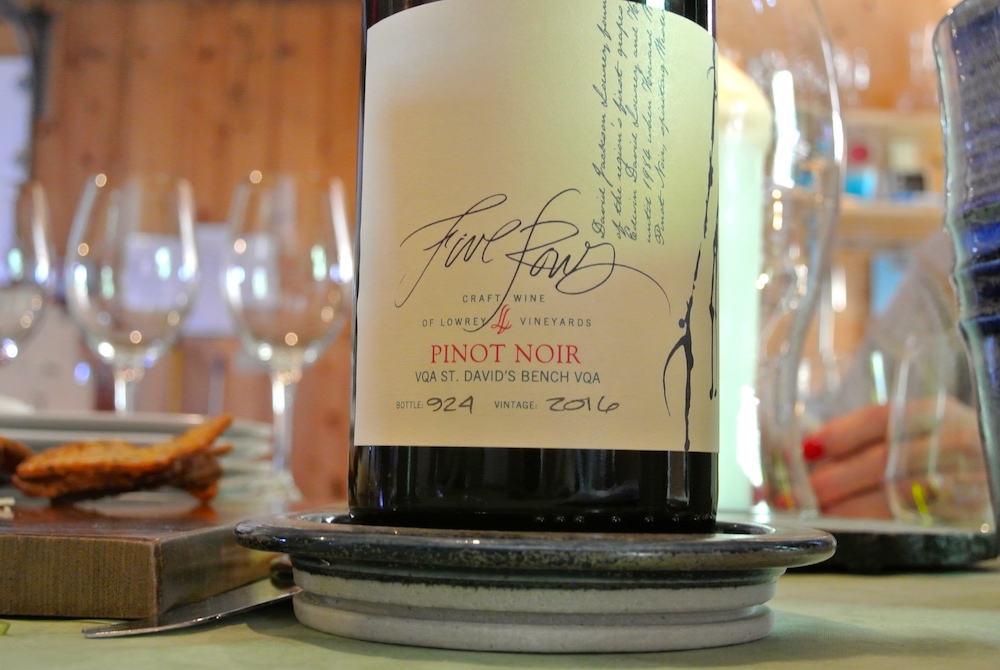
Five Rows Craft Wine Pinot Noir 2016 ($55, 93 points) — Lowrey gets it right in his blog when he says Pinot is hardest to make in ripe vintages like 2016, but he made all the right calls in the vintage during the hot, dry months and ultimately picking decisions to craft this Pinot from the iconic original vines from the estate (mixed with some newer vines). It is definitely a more masculine version of Lowrey Pinot with a nose of earth, foraged mushrooms, bramble then black cherries, wild raspberries and woodsy/spicy notes with a violet/floral component. There is an earthier feel on the palate than previous vintages with evident tannins that should melt away with time to better show the core of red berries, tart cherries and lovely spice notes that’s all kept vibrant and tangy by the acidity. Can likely cellar 7+ years as it comes into balance.
Winemaker’s notes:
It stands to reason that the most difficult years to craft good Pinot Noir are usually the best years for later varieties like Syrah and Cabernet Sauvignon. Namely, it’s easy to overdo your Pinot when they are rapidly ripening in the hottest part of the summer (think 2007 vintage versus 2009). Leaning on past experience, I took steps to delay the maturation process in 2016 – with a later thinning of green clusters (post-veraison) and less intense leaf removal.
All of these efforts did not go unnoticed, as in my harvest notes I have scribbled: “By far the cleanest we’ve ever picked” – Wilma
The advantage of older vines vs. younger vines was also apparent in 2016, as we saw the fruit in our younger block (Clone 777) ripen quicker and lose acidity much faster than our older block (Clone 115). We chose to hand-harvest 2500 kg from rows 2, 3, 4, 8, 9 and 14 of our Old Block on September 13th, 2016. The clusters were sorted three times on the way to three separate one-tonne bins, and fermentations were allowed to start spontaneously after a four day cold soak at 15 C. Each bin was then inoculated with cultured yeast at 1/3 sugar depletion to aid in finishing. The wine was housed in French oak (30% new) for 24 months.
The end result is an elegant Pinot from a hot vintage, with ample acidity and tannins that should help it develop in bottle. Ripe with familiar, terroir-driven notes of wild strawberry, cranberry, cherry, truffle and spices, it should age well to 2024.
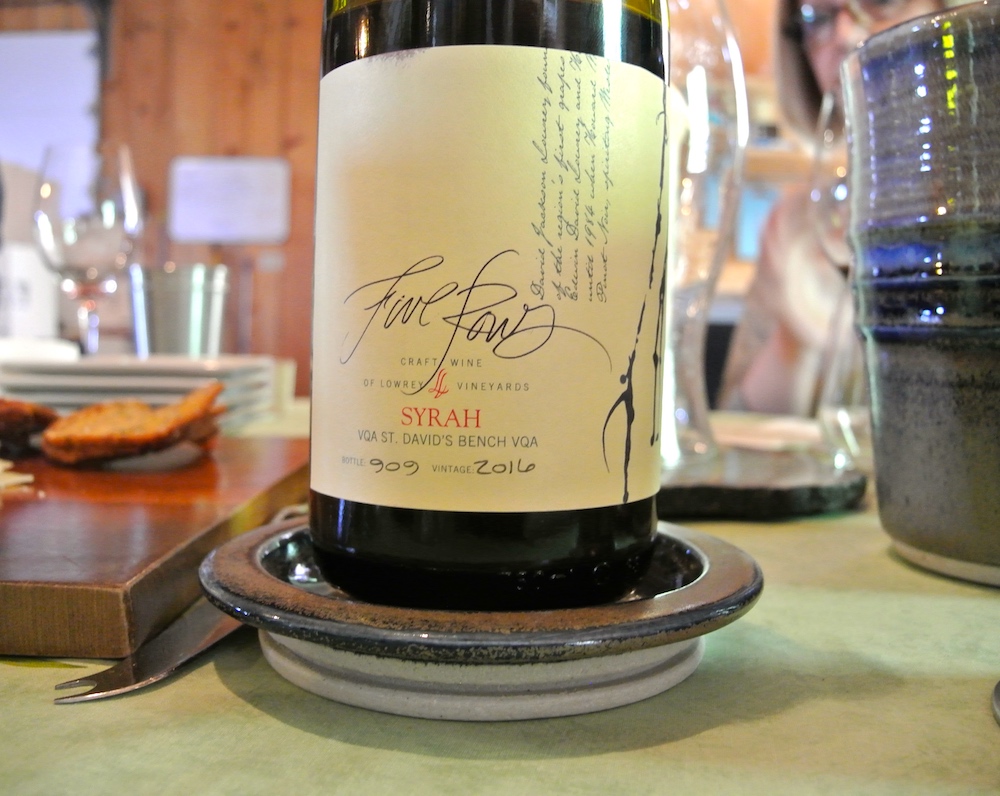
Five Rows Craft Wine Syrah 2016 $55, 92 points) — Lowrey has done an excellent job of keeping this Syrah in check from the soaring heat of 2016. Such a personable and textbook Syrah with a nose of grilled meats, charcuterie, black currants, anise, peppercorns, earth, smoke and a range of barrel spices. The fruit leads the charge on the palate with underlying earthy, gaminess, forest floor and smoky spice and pepper notes that is nicely balanced on the long finish. “Right now, this is my favourite of the reds,” Lowrey says. Quite approachable right now.
Winemaker’s notes:
Hand-harvesting for the 2016 Syrah took place on October 11th, with about 1000 kg sourced from each of our Clones (7 and 100). The fermentations were conducted in open top bins and manually punched down three times daily. They were allowed to initiate spontaneously after a four-day cold soak, then inoculated with RX60 (Clone 100) and FX10 (Clone 7) on day 6. Both bins were pressed after a total time of 14 days on the skins, then racked to barrel and inoculated with malolactic bacteria MBR31. The wine was aged in French oak (20% new) for 24 months.
Early on, I worried the 2016 Syrah would come across so ripe that it would be considered more of a one-off vintage than a typical example of our cool-climate style. But as the wine evolved in barrel, I became more excited about its prospects of becoming something unique, yet familiar at the same time. This complex Syrah comes at you with aromas of dark fruit, sweet peppercorn, and floral notes. It is both ripe and savoury on the palate, with surprisingly smooth tannins; should age well to 2024.

Five Rows Craft Wine Cabernet Sauvignon 2016 ($55, 91 points) — I admire Lowrey’s tenacity for Cab Sauv in Niagara. He loves this variety and has stuck with it through some very lean years. It pays off in a vintage like 2016 and you get a sense of why so many grow it and suffer through the cooler years. “It’s not a big bruiser by any stretch,” says Lowrey. It’s textbook Cab Sauv on the nose with ripe blackberries, cassis, anise, elegant spice notes and cocoa/leather accents. It’s rich and ripe on the palate with good tannic structure, dark fruits with some cherry/raspberry accents and wonderful spice all propped by mouth-watering acidity. Quite approachable now, but can cellar 4+ years.
Winemaker’s notes:
On November 9th, 2016, we hand-harvested 1500 kg of beautiful Cab from a combination of rows 8, 9, 10, 12 and 13 in our Clone 169 Block and rows 8 & 13 in our “Old Block” – and in retrospect, I wish we had kept a few more rows for ourselves!
The fermentations were allowed to start spontaneously after a four-day cold soak, then inoculated with FX10 (Clone 169) and F15 (Old Block) on day 6. Peak fermentation temperature reached 30 C, and the bins were pressed after 15 total days on the skins. Aging was carried out in French oak (25% new) for 24 months.
I’m of two minds on the 2016 Cab Sauv, in that it is showing very well right now – much smoother than similar versions at release (2007, 2010, 2012) – but I do feel this wine will only improve and blossom with age. I can say this with much more confidence than I used to, based on the feedback we’ve received from the many people aging our Cab’s going back to 2004.
Showcasing an abundance of the classic cherry and cassis notes associated with our terroir, this wine smells as intense as it tastes. There is a richness to the palate, with good balancing acidity and evolved tannic structure. It should age well to 2025 and, perhaps, beyond!






Comment here